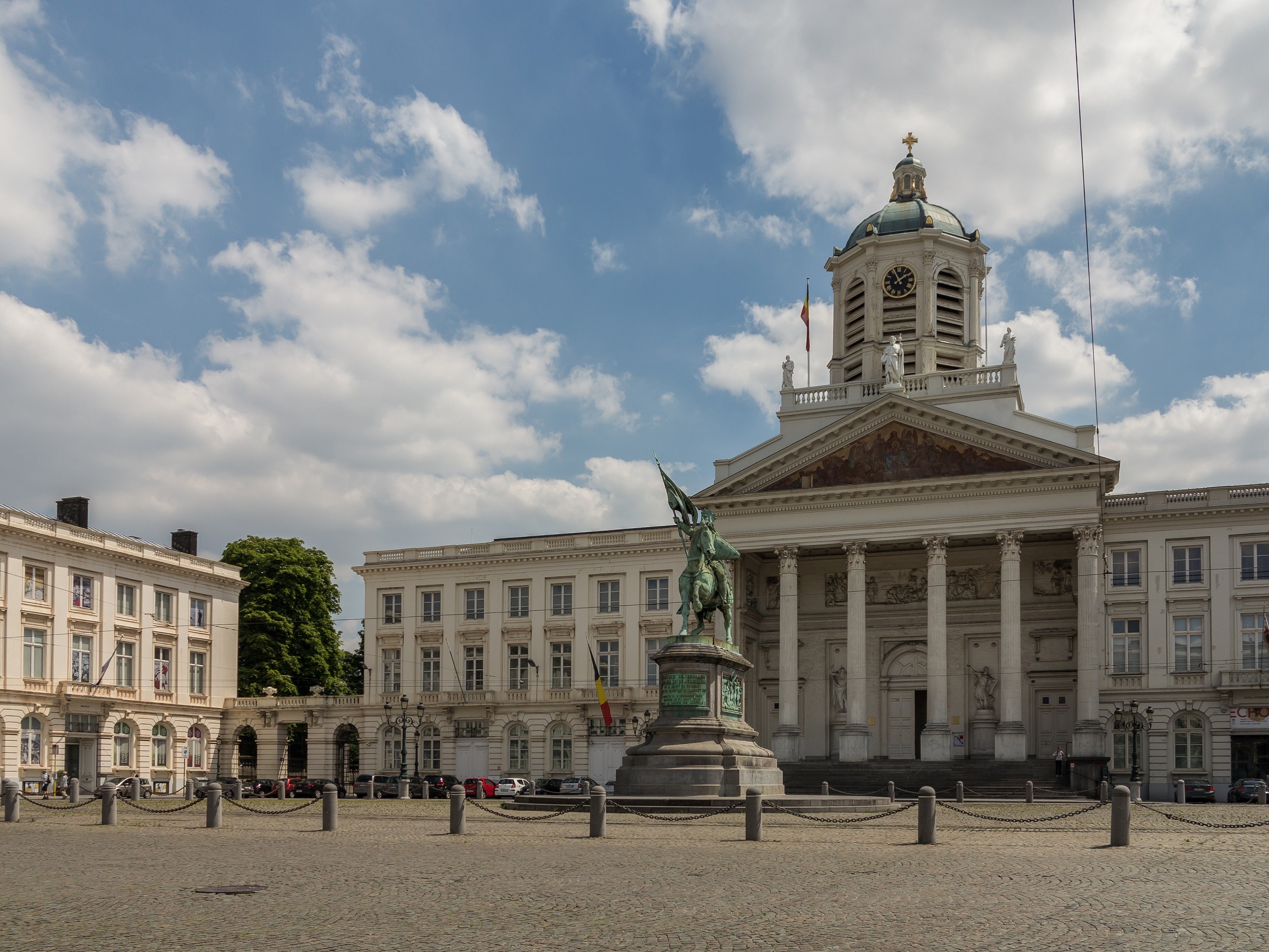Place Royale is the great survivor of Brussels. Its late-18th-century architecture appears to have emerged unscathed from its first quarter millennium of existence. The cobbled mosaic of its road surface is battered but still in place, as are its bluestone pavements, often said to be the first in Europe.
Perched 45 metres above the lower town, it offers three magnificent perspectives: two closed by distant 19th-century domes and the third by the medieval spire of the old Hôtel de Ville below in the Grand Place. Unlike that car-free tourist honeypot lined with its back-slapping parade of gilded stone attention-seekers, the more severe facades in Place Royale are perhaps more admired than loved.
That severity has long intimidated the city’s planners, warding them off any visible changes. For a century, strollers have had to dash between cars as well as trams to the safety of the plinth of the statue in the centre to enjoy those perspectives or steal a glance behind a bus from one of the crossings. Instead, tourists tend to pool down the hill at the summit of the Mont des Arts.
This is set to change as work starts on the latest pedestrian-friendly Brussels beautification project. In recent decades, just 20% of the site has been dedicated to those on foot, with the remainder allocated to motorised transport. By 2025, this situation will be more than reversed, with 85% reserved for pedestrians, although they will have to share it with cyclists.
As at the projects planned for the Schuman roundabout and Ave de la Toison d'Or, the aim is to tame, not remove motorised traffic. All three schemes hope to adapt historic sites that pre-date cars to 2020s mobility policy, meaning the reversal of the harrowing legacy of car-first planning from the second half of the 20th century. Place Royale is the oldest and by far the most delicate from a heritage perspective.
Curtailing traffic
The only revolutionary aspect of the scheme is that traffic will cease to revolve around the statue in the centre of the space. Instead, cars, trams and buses will pass through a breadcrumb trail of discreet bollards forming a bow on the west side. The entire east side in front of the church will become a coathanger-shaped public space, with newly-relaid cobbles and restored pavements. LED mood lighting will enliven the experience after dark, and for the first time in decades there will be somewhere to sit.
Stone benches will encircle the central statue and wait each side of Rue de la Montagne de la Cour for those who have hiked up the hill from the Grande-Place. When work is complete, Place Royale will be one of the largest public spaces in the region, according to Ans Persoons, Brussels State Secretary for Urban Planning and Heritage.
With improved pedestrian access to Place Royale from the immediate approaches, the project is squarely aimed at tourists, encouraging them to linger on the way to or from the park, the museums and the downtown via the Mont des Arts. While the City of Brussels is on the hook for new traffic lights, bus stops and bins, the state will pay for most of the work via Beliris, the Brussels infrastructure agency. But no fresh attractions are planned, no trees either and the budget is a modest €6.3 million. On the face of it, the changes are somewhat superficial for a project six years in the making.
That’s perhaps to be expected, because views aside, Place Royale is little more than the sum of its neoclassical facades and vintage road surfaces, beneath which there is no room for deep tree roots.
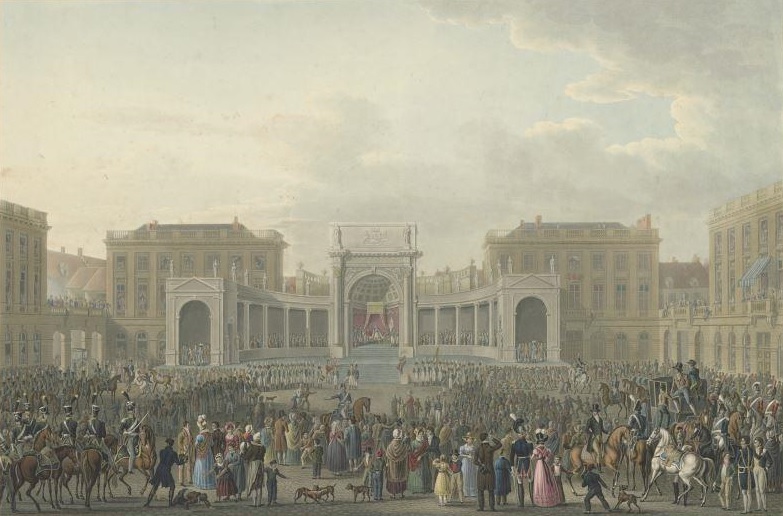
The inauguration of William 1, King of the Netherlands, 1815
Paradoxically, the square is one of the city’s best preserved and least well-preserved sites, both physically and in nature. Virtually no original interior elements survive and what was once one of the most intensely sociable locations in the city has been reduced to a stage set. While there are nominally four museums on the square, they are mainly entered from surrounding streets. Many of what were front doors have not been used in decades, giving the place the feel, if not the appearance, of an alleyway.
A hidden feast
It wasn’t always this way, a rectangle of grandiose institutional fire exits. Far from the aristocratic residential enclave it might appear to be, Place Royale was a mixed development from its inception in the 1770s, with offices as well as homes. Cabs would later crowd the central section, and the square came to be lined with shops, hotels, banks and cafés.
Under terrace awnings, café customers enjoyed those facades in their authentic context, as a backdrop to the theatre of urban life. Nowadays, you can’t even get a cup of coffee there, let alone sit down. The only catering on hand is waffle vans, those ambulances providing first aid to distressed Brussels tourist spots.
Yet a few centuries back and a few metres below those queues for stand-up snacks, hundreds of diners would sit at tables, guests at the feasts in a grand banqueting hall, whose remains have been open for visits since 2000. One of Place Royale’s newest attractions is also its oldest, its predecessor on the site in fact, the buried ruins of the Coudenberg Palace. Waterproofing the roof of those remains in the northwest corner marks phase one of the renovation work and perhaps the first step in returning this location to its place among the must-visits of Brussels.
The creation of a castle at the site of present-day Place Royale dates back to the 11th century, when the local ruler chose a spot on the safer, healthier heights to the east of the city, the Coudenberg (cold mountain). As the importance of Brussels grew, this defensive nucleus sprouted into a complex that sprawled across a plateau between two valleys, shielded from outside attack thanks to a bespoke kink in the city’s first wall (a fragment survives above ground in nearby rue Brederode).
On the western edge of the plateau overlooking the lower town, the Aula Magna, or great hall, was built in the 1450s for Philip the Good at the expense of the city, hoping the Duke of Burgundy’s travelling court would linger in Brussels. From the 1520s, Charles V, Emperor as well as Duke (and semi-permanent Brussels resident), had this extended to the north by a chapel whose choir plunged many metres down into the valley of the Coperbeek, which flowed downhill to meet the Senne river at present-day Boulevard Anspach.
A residential wing stretched at a right angle to the chapel and featured a gallery giving dramatic views north over the stream to a wooded hunting ground, the Warande, now the Park of Brussels. Opposite the Aula Magna across an inner courtyard and a small square known as the Places de Bailles was the church and buildings of the Provost (later Abbey) of Coudenberg. More or less a dead end, the site was bordered to the south by the steenweg, the main east-west road through Brussels.
In February 1731, a great blaze at the palace consumed the residential wing and damaged much of the complex. The frozen water on the cold mountain complicated firefighting and while the chapel was mostly spared, only the walls of the Aula Magna remained.
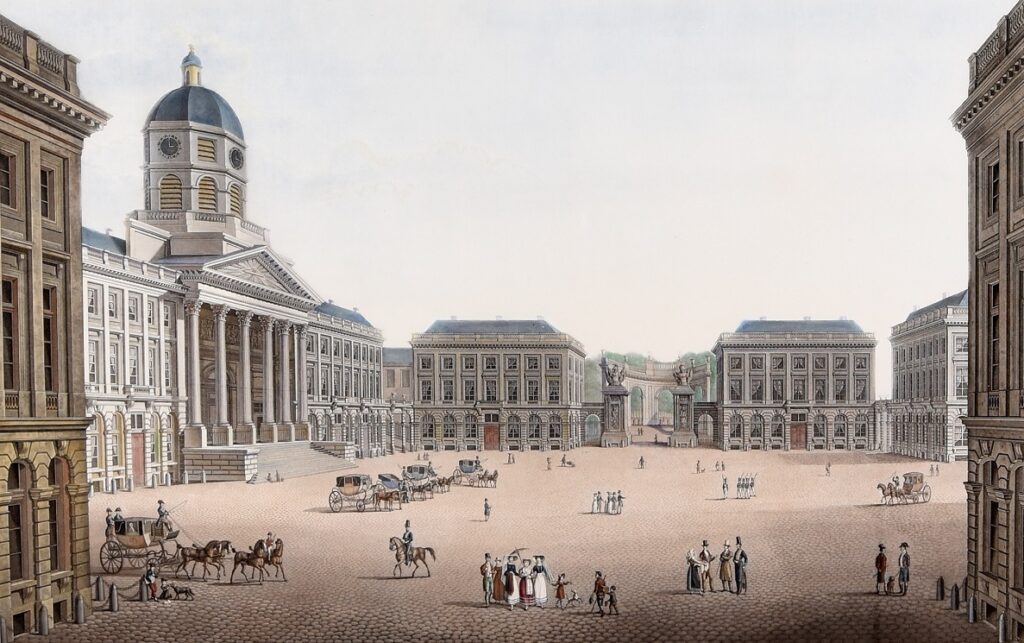
Place Royale circa 1770
Much reduced in prestige since the abdication of the Emperor, the days of chivalric feasting and hunting had long been over for Brussels. Belgian nationhood (and local monarchy) was still a century away. Instead of rebuilding the kingly hilltop resort in this now provincial court, the Austrian governors left it to rot and created a new palace further down the slope into Brussels by knocking together some existing courtly mansions.
In the 1760s, Charles de Lorraine, governor for 40 years of the Austrian Netherlands, art lover and collector of books and manuscripts gave them a new wing in a neoclassical style reflecting his enlightenment tastes (the Royal Library of Belgium sits behind this facade now).
A city crowned in white
A decade later, the government finally decided to do something about the ‘burned court’, as Coudenberg had become to be known, when a statue of Charles was proposed for the centre of the old courtyard. The 18th-century preservationists would be disappointed. Instead of restoring the late-Gothic chapel and re-roofing the medieval Aula Magna as hoped, the authorities had them razed for the sake of economy.
To plans from French architects Barnabé Guimard and Jean Benoît Vincent Barré, engineers levelled out the court and its old gardens and hunting ground to create what were effectively two rectangular squares lined with mansions. Firstly, on a previously-undreamt-of scale, surrounding a new landscaped pleasure park replacing the hunting ground (a section of the Coperbeek valley survives in the southern end of the present-day Park of Brussels). Another, far more intimate, the Place Royale, replaced the ancient, mismatched palace buildings.
Along the exposed jawline of the old court’s northwestern edge overhanging the city, jagged remains of the floors and cellars of the Aula Magna and Chapel served as foundations for the new buildings of Place Royale. Gone was the fun baroque touch of the concave entrance to Charles’ palace. A series of letters patent decreed uniform, flat, rendered facades, and a gleaming white Austrian crown was set atop the red-brick stumps of the Burgundian past, well above the previous ground level.
This haughtiness of the Place Royale, architecturally and literally (it sits 45 metres above the central boulevards of Brussels), has challenged the city’s authorities ever since. The perpendicular geometry of the square and park dictated the trajectory of new streets across the future sprawl of prosperous eastern Brussels in the decades to come. This left Place Royale as both immutable monument and a crucial node in a communications system stretching southeast to the Bois de la Cambre via the future Palais de Justice and Avenue Louise and north to Schaerbeek via Rue Royale. The difficult connection west to the lower town, exacerbated by the extra height, was left hanging for now.
A tourist hub
The Enlightenment was also that of recognisably modern economics. Unlike its courtly predecessor, the new square would have to produce as well as consume wealth. The eight pavilions lining the Place Royale were brought into being via an embryo and muscular form of public-private partnership. In addition to aristocrats building homes here, the imperial lottery-built numbers 1-2 (now the Magritte Museum) and the abbeys of Coudenberg and Grimbergen were leaned on to build numbers 5-8 and 10 respectively, the former sacrificing its church (their reward would be the suppression of their orders during French revolutionary rule).
Number 9 meanwhile, now the BELvue museum, was from the start a travellers’ hotel targeting luxury, especially English, tourists. The Duke of Wellington used the Hôtel Belle-Vue as his base when visiting Brussels after Waterloo.
Fifteen years after Waterloo, another battle took place in the former hunting ground. With the same viewpoint from which Renaissance aristocrats had watched the hunt, English officers were caught up in the Belgian Revolution of 1830 while on a summer city break in Brussels. They watched transfixed from the Belle-Vue’s windows as patriot snipers picked off Dutch troops in the park and as a cannon on the hotel’s terrace ripped through the trees.
Wellington’s niece Lady Charles Bentick was among a group of English female guests forced to take shelter in the larder for three days. Harangued by Lady Bentinck, demanding to know if they should evacuate, the hotelier, weighing the loss of income against potential public relations fallout, told her they should. With musket balls whistling past their ears, the women were led through the square and down to the safety of the maze of streets in the old town by a detachment of bourgeois.
A year later on July 21, the swearing-in ceremony of a new King of the Belgians, Leopold I, was held in front of the Church of Saint-Jacques (on a spot which would soon be occupied by the largest section of the new pedestrian zone – perhaps this newly-conquered public space will again host events, but the city isn’t saying).
Arriving from England, Leopold was following in the footsteps of a large British community that had taken up residence in the Place Royale quarter soon after Waterloo. Some were economic refugees from the cost-of-living crisis in London but many had come to do business. Over the decades a network of British booksellers, shipping and house agents, banks and inns would spring up in the square and surrounding streets.
Crusader king
In 1848, Leopold would preside over another ceremony aimed at emphasising Belgian statehood. On August 15, the royal family assembled on the first floor of the Hôtel Britannique to witness the inauguration of a statue of Godefroid de Bouillon, the 11th century crusader king, born in what would later become Belgium and as such a national hero. It took the place once occupied by the statue of Charles V – melted down by the French in 1794 to make coinage, finally paying its way like the rest of the square – to be replaced by an arbre de la liberté (probably the only tree the square will ever know).
Remarkably, this display of order and tradition took place just six months after Leopold’s father-in-law, Louis Philippe, had been deposed in a new revolution in Paris, by then a direct train ride away, and as unrest continued to seize European capitals. The Comte de Mérode made a speech pointing out it was all his idea and promising a new crusade.
This time, no doubt with an eye on Paris, a crusade against poverty and misery. A specially composed Hymn to Godefroid was sung. A hit, it would be covered in 1850 by a choir of 1,500 at the Antwerp music festival. In 1851 in London, a copy of the statue of Godefroid was the centrepiece of the display of Belgian industry and technology at the Great Exhibition. The business of Belgium was business.
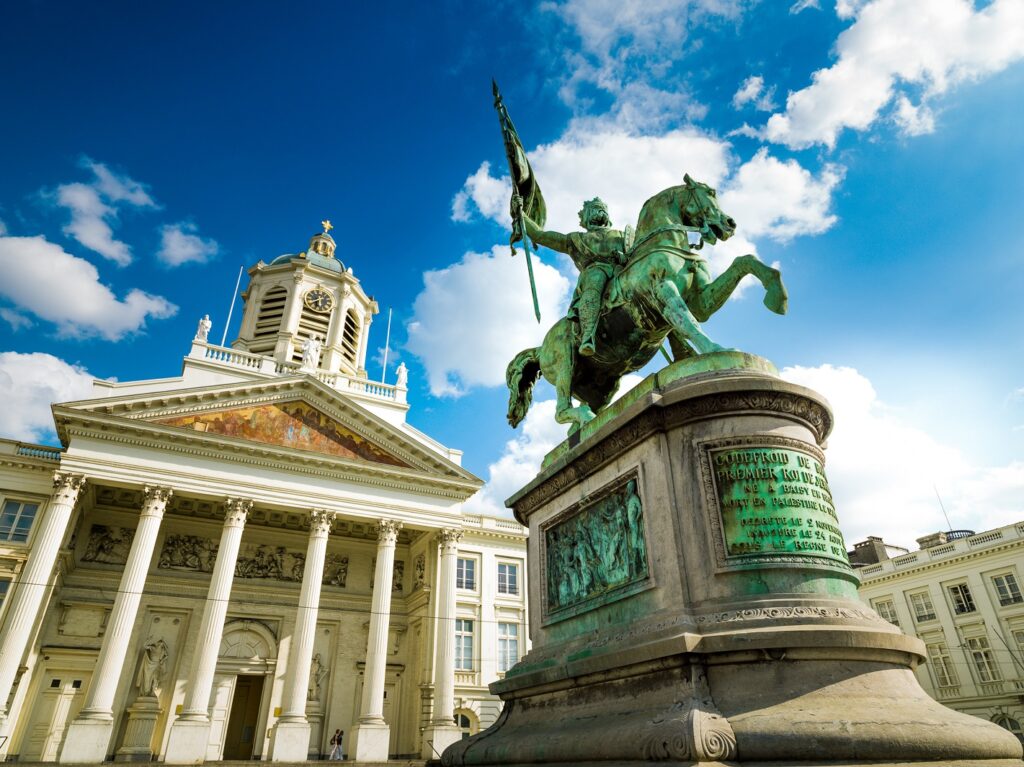
Godefroid de Bouillon
In the decades leading up to the First World War, it was business that would dominate Place Royale, the hospitality business above all. To the left of the mouth of Rue de Namur was the Globe Tavern, its awning stretching out over the pavement and its wine cellars stretching north beneath the church.
To the left of the church was the Hôtel de Flandres with its famous restaurant and winter garden. It came under the same ownership as the Belle-Vue next door and their owners the Dremel family, tireless boosters of the upper town of Brussels, would milk the 1830 associations for all they were worth as well as a list of guests that reads like a roll call of 19th-century royalty. Unable to knock the two buildings together because of the strictures protecting the colonnade that separated them, they built a tunnel between them.
For decades at number 10 (now BIP House of the Capital Region), the Café de l’Amitié offered views over the park. At Number 14, the Taverne de La Régence had replaced the old Hôtel Britannique that had once hosted the royal family. It spread its awning out wide over the spot covering the Aula Magna. The Hôtel de l’Europe at numbers 1-2 occupied the space façadised in the 1980s and now hosting the Magritte Museum. At their late 19th-century peak, Brussels hospitality venues welcomed diners and guests behind perhaps half of the square’s front doors.
Hotels pack their bags
Designed from the start to accommodate new interiors behind unchanging facades, the financial and commercial sector also arrived in the square and began to edge out hospitality. The Gresham insurance company acquired Baron Osy’s residence at number 3 in 1900 and had architect Léon Govaerts perform a spectacular Art Nouveau transformation of its entry halls behind an unchanged white facade.
As well as Gresham, other offices moved into this business incubator, many American, including the Pittsburgh Plate Glass Company, and Govaerts’ own architectural practice. By 1914, the Old England department store (now Museum of Musical Instruments) a few steps away down Rue de la Montagne de la Cour, refused permission to extend its vast Art Nouveau premises over the square, took over the Taverne de La Regence for extra retail space.
At the beginning of the 20th century, as not just trams but also cars began to rattle across Place Royale, its hotels began to close. Unable to expand to compete with much larger purpose-built rivals, they began to suffer from their poor connection to the lively lower town, transformed by the new boulevards built over the Senne river. As trade flowed downhill, following the course of the ancient Coperbeek, fantastic schemes were dreamed up to fix the altitude problem.
The palace beneath the square
Interest in what lay beneath the square revived around 100 years after its creation. The architect of Old England, Paul Saintenoy, became a lifelong obsessive about the vanished Coudenberg and hoped to have a replica of the Aula Magna to his design erected in the old Brussels section of the 1897 International Exposition.
It didn’t happen and Saintenoy perhaps contented himself with an echo of the great hall via the addition of a large polygonal turret to the facade of Old England (he lived to see the replica built for the 1935 Expo).
[caption id="attachment_1148560" align="alignnone" width="902"]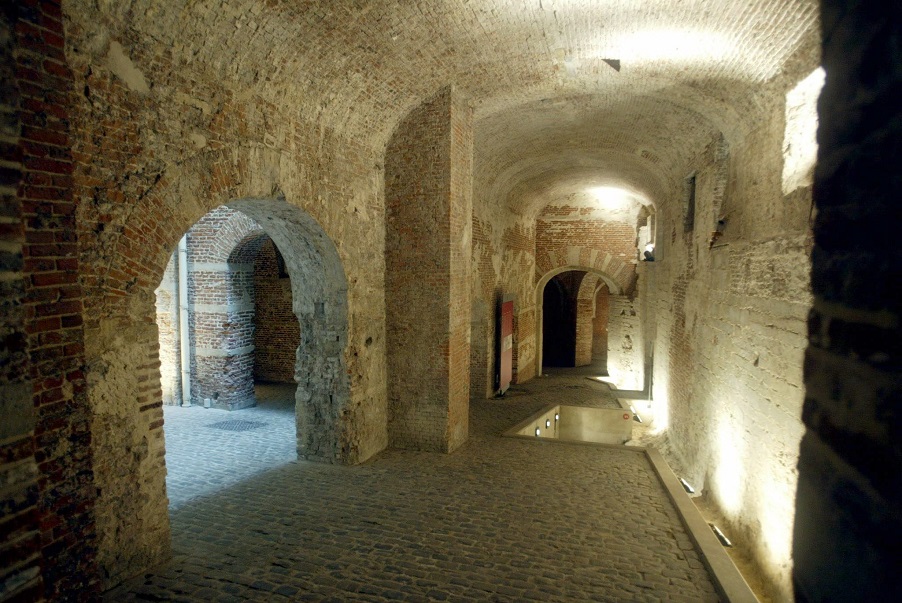 The remnants, under the square[/caption]
The remnants, under the square[/caption]
In 1984, the remains of Coudenberg under the BIP were declared a monument and 20 years later protection was extended to the buried Rue Isabelle and the Aula Magna itself (it wasn’t always smooth progress – in 2003 the entire floor of the ancient hall, 500 blue and white paving stones forming a chequered pattern, were stolen from their storage place beneath the expressway in Auderghem).
Opened to the public in 2000, Coudenberg is perhaps the Square’s finest feature, but it can only be accessed by following in Lady Bentinck’s footsteps down into the basement of the BELvue and following a circuitous route under Rue Royale. You can however get a glimpse of the ruins from the square through the emergency exit door under the BIP gift shop.
An 880-metre-long, illuminated iron viaduct leading pedestrians from the park to Place de Brouckère 40 metres over the city was suggested. The Dremels proposed a palace hotel, a city within a city by the royal palace itself that would feature a 15-metre-deep tunnel accessed by an elevator and connected to Boulevard Anspach. By now, however, the jewel in the family crown, the Belle-Vue hotel, had been acquired by the crown itself for royal purposes (it became the BELvue museum in 2005).
The altitude problem would be solved, to the satisfaction of none, by means of far more mundane technology. The remaining medieval quarter that had sat just below the Coudenberg Palace was razed in the first decade of the 20th century to accommodate the present-day Bozar, among other institutions. Supported by concrete pillars, the curving ramp of Rue Ravenstein made up the height difference between lower Brussels and the Place Royale, jacked up by 18th-century engineers.
Two world wars put an end to the hospitality industry in Place Royale. By 1919, the last hotel, the Europe, was a government ministry, and in 1949 the last café, the Globe, was converted into a bank by the Belgian ancestor of ING. The final refreshments on the square dried up in the 1970s with the closure of Old England and its tea room on the site of the old Taverne de la Régence and above the buried banqueting hall. And with that, the square turned its back on the city.
Institutional desert
While the base of the statue will be restored as part of the work, Godefroid himself will not. Last cleaned in 1990, his return to the square marked the start of the last major three-year renovation of Place Royale. This plan included the rebuilding of the former Hôtel de Flandres (by then the African Library of the old Ministry of Colonies) to create a court and of the old Gresham offices for the use of the Royal Museum of Fine Arts.
The plan’s centrepiece was the re-erection of the facade of Victor Horta’s 1899 Hôtel Aubecq along the vacant south side of Rue Montagne de la Cour. Standing opposite its exact Art Nouveau contemporary, the Old England (to be restored as the Museum of Musical Instruments), it would have fronted a complex of apartments and shops as well as serving as a central reception area for the museums around Place Royale.
However, the Horta plan was dropped amid concerns over its impact on the view to the Grande Place and on the adjacent neoclassical facades. Instead, the customary Brussels compromise has left the space as collection of hedges ever since. On the square itself, the demolitions of the buildings behind the facades meanwhile went ahead unopposed.
Today, of the eight original pavilions all but one are in institutional hands. The eighth, the former Globe at number 5-6, was last used by ING as a gallery to show off its art collection and now stands empty. It was bought in 2022 by an investment fund associated with the Jaspers-Eyers architectural bureau but they haven’t revealed their plans for the building.
In the 2012 Belgian deep-state police TV thriller Salamander, spooks conspiring against the police are seen entering the old side door of the Globe to access their secret HQ from a deserted, shadowy Place Royale. It would have been a nonsense to set such a scene in the Grand Place but Place Royale is set in the public imagination as a non-accessible location. At some point, the square had died.
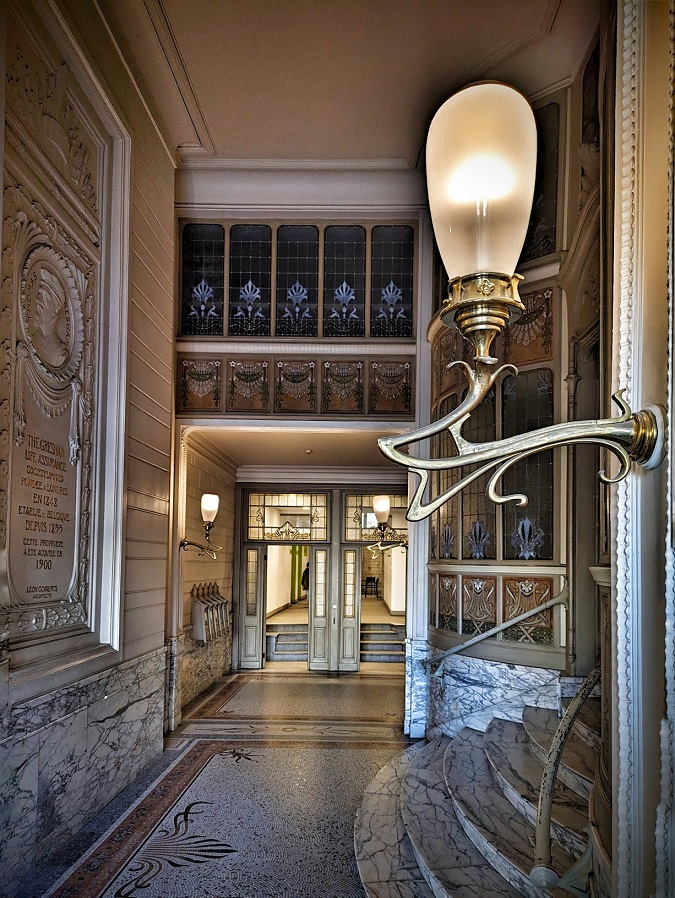
Interior of the former Gresham offices, now part of the Museum of Fine Arts
The city and region of Brussels want Place Royale to become once again a place to linger and savour those views: the architecture of the square itself of course, but also the vista of the dome of the Palais de Justice, scheduled to shed its 45-year old scaffolding in time for Belgium’s bicentenary in 2030, when it commemorates the independence won in that battle witnessed by the Belle-Vue.
The blue-stone benches are a good start. They will feature copper tones - it wouldn’t be 2020s Brussels without a little touch of bling - and are perhaps the only gesture to change allowed by the Royal Commission for Monuments and Sites (CRMS/KCML) over the long gestation of the project, when authenticity and faithfulness to the square’s original design was insisted upon.
Perhaps the most authentic gesture of all would be the eviction of Godefroid, an anachronous romantic-period sculpture out of proportion to the neoclassical square. Mercifully, an early proposal to place him in the centre of a circular lawn, like a giant, armed garden gnome, was dropped.
The arrival of Godefroid in 1848 was part of yet another renovation of the square along with the entire Royal Quarter led by the architect Tilman-Francois Suys. The pavements, the cobbles, the belltower on the church of Saint Jacques and the railings around the park all date from this campaign, and this mid-19th century version is what the CRMS uses as its benchmark for authenticity. Anticipating criticism of this (rather arbitrary) asceticism imposed on the renovations, notably the absence of any greenery, Ans Persoons observed that, “historically, there were no trees on neoclassical squares” but that climate-change factors could lead to “reflection on the subject in the future”.
A place in the sun
For now, at least, there will be no trees to provide welcome shade on Place Royale. But that should not prevent the square from being more welcoming. As well as the treasures below its surface in the Coudenberg palace site, there are many more behind its facades that could persuade visitors to linger if those institutions were permitted to show a little more imagination.
Further remains of the Coudenberg Palace and of the winter garden of the old Hôtel de Flandre are known only to those with business at the Constitutional Court. The former salon of the Café de l’Amitié, transformed into a banking hall for Lloyds and National Provincial Foreign Bank just before World War One, still has that enchanting view over the park, but is a meeting room for the BIP.
Would a friendly café in there for Brussels visitors not be a fine gesture from Visit Brussels? And do Govaerts’ spectacular Art Nouveau delights at the old Gresham building not deserve a better fate than being an exit through the gift shop? Hidden behind the BELvue, there is a leafy and beautiful outdoor café where the cannon stood in 1830. Perhaps thanks to a small revolution, instead of bins, a second terrace could occupy its corner of the square. Covered of course by a big, authentic old-fashioned awning, as Place Royale recovers its place in the sun.

